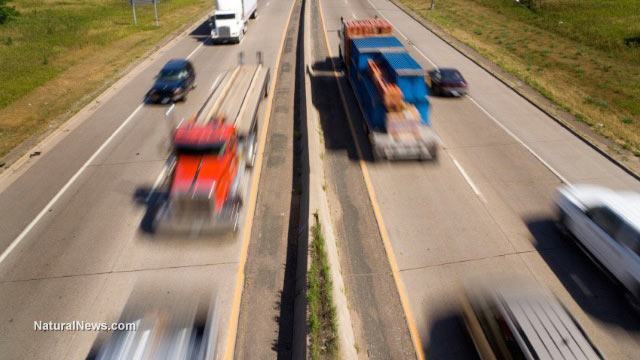Ambitious or insane? Nation's roadways can be turned into functioning solar panels, say inventors
Monday, June 09, 2014 by: J. D. Heyes
Tags: solar panels, roadways, alternative energy

- TAKE IT DOWN Act advances in Congress amid free speech concerns
- Gardening tips: 15 Simple tricks to double your garden’s yield this season
- Survival 101: Dangerous places to avoid when disaster strikes
- Hospital staffers sound alarm after 10 nurses were diagnosed with BRAIN TUMORS
- Nature’s arsenal: How plant compounds power military survival and healthcare in crisis
- Kawasaki unveils rideable ROBOT HORSE powered by hydrogen
- Criminal referral requests filed against Fauci and top COVID officials in seven states
- DOJ and ATF kill Biden’s “Zero Tolerance” firearms dealer policy
- Widespread social and economic unrest: Steve Quayle issues urgent financial warning of imminent asset collapse in new interview with Mike Adams
- Aerosolized bioweapons? Strange “diploid biomasses” falling out of the sky in Florida captured under the microscope
- Analysis: The coming economic collapse, a mass uprising and Trump's three secret weapons to halt the growing revolt
- Israeli lobbyists boast of controlling US national security policy in leaked AIPAC audio
- New studies ignite debate: Fluoride linked to autism and ADHD, prompting calls for policy reassessment
- “Prepare Tribe: Prepare, Protect, Provide” on BrightU: How to build a disaster-proof shelter in the middle of nowhere
- Barley: A nutrient-dense ancient grain with modern benefits
- Sovereign debt paradox: U.S.-China mutual holdings fuel geopolitical tensions
- Amazon's Kuiper satellite launch delay highlights uphill battle against Musk's Starlink
- Federal appeals court authorizes DOGE access to Education, Treasury and OPM records
- Tulsi Gabbard leads charge against the Biden regime’s global censorship of the 'Disinformation Dozen'
- Fauci is back in the limelight, and he’s busy promoting a future COVID or FLU pandemic
- Aerosolized bioweapons? Strange “diploid biomasses” falling out of the sky in Florida captured under the microscope
- Analysis: The coming economic collapse, a mass uprising and Trump's three secret weapons to halt the growing revolt
- Widespread social and economic unrest: Steve Quayle issues urgent financial warning of imminent asset collapse in new interview with Mike Adams
- Kiss Your Genetic Privacy Good-Bye! 23andMe Gets Green Light to Sell Your Intimate Genetic Details to Anyone They Want
- Tulsi Gabbard takes aim at censorship: Justice for the ‘Disinformation Dozen’
- Mike Adams releases country western hit single: Goin’ Back in Time is Comin’ Home
- U.S. lawmakers investigate Meta over alleged China collaboration
- CLOT SHOT PLANDEMIC UNFOLDING: Fibrous, rubbery clots caused by covid injections have prion-like seeding activity
- Chemtrails unveiled: How the CIA and Big Business are manipulating the weather for profit
- How Israeli military-connected corporations are secretly controlling your online privacy
- European Court of Justice: Healthcare professionals who promoted or administered COVID-19 vaccines are CRIMINALLY LIABLE for any harm caused
- DEATH by VACCINE or face PRISON time: Canadian Freedom Convoy leaders CONVICTED for protesting forced vaccination during the Covid Plandemic
- Defunding DEADLY mRNA jabs: Government funding for mRNA technology being scrutinized and sidelined until proven "safe and effective" for real
- Federal employees whine over DOGE's new directive requiring them to do a 5-point summary of weekly accomplishments
- U.S. approves new Russian ambassador as diplomatic thaw continues
- Curcumin’s ancient healing power supercharges muscle recovery, and its effects are compounded with anti-inflammatory foods and supplements
- Newly released JFK files reveal Pentagon's role in creating Lyme disease and covid in the same lab
- Analysis: The coming economic collapse, a mass uprising and Trump's three secret weapons to halt the growing revolt
- Mike Adams releases country western hit single: Goin’ Back in Time is Comin’ Home
- Aerosolized bioweapons? Strange “diploid biomasses” falling out of the sky in Florida captured under the microscope
- Kiss Your Genetic Privacy Good-Bye! 23andMe Gets Green Light to Sell Your Intimate Genetic Details to Anyone They Want
- Dr. Mike Yeadon releases 15-minute testimony - WATCH - about genocidal intent of COVID “vaccines”
- Trump reverses course on Gaza plan, says “nobody is expelling Palestinians”
- MEDICAL BOMBSHELL: FDA admits Covid mRNA 'Vaccines' CAUSE CANCER
- European Court of Justice: Healthcare professionals who promoted or administered COVID-19 vaccines are CRIMINALLY LIABLE for any harm caused
- The Health Ranger releases “Vaccine Zombie” song and music video, using AI-animated zombies for the music video
- 5 Simple steps to boost your brainpower: How to strengthen executive function in a distracted world
- A lack of integrity in Academia: Harvard professor found GUILTY of fraudulent research to promote CRT theory
- Federal employees whine over DOGE's new directive requiring them to do a 5-point summary of weekly accomplishments
- EPA advisor admits the agency is funneling billions to climate groups ahead of Trump’s return to White House
- California's social media censorship law struck down: A victory for free speech or a threat to online safety?
- Space war brewing? Russia threatens to destroy Starlink satellites
- Survival 101: Effective EMF blocking techniques
- Rep. Nancy Mace introduces bill to ban biological males from female facilities on federal property
- Red Cross issues warning to stop blood plasma donations from vaccinated people
- Scientists confirm: GENIUS brain function can be spontaneously unleashed in humans without any apparent cause
- EPA advisor admits the agency is funneling billions to climate groups ahead of Trump’s return to White House
- HYSSOP: What research reveals about the health benefits of this ancient holy herb
- Two containers with completed ballots fall out of truck in Florida
- Newly released JFK files reveal Pentagon's role in creating Lyme disease and covid in the same lab
- Global leaders unite to clamp down on “misinformation” with UN-backed Cascais Declaration
- BREAKING: 2025 NDAA authorizes mandatory military draft of WOMEN across America… as Pentagon pursues global NUCLEAR war with both Russia and China at the same time
- Michael Yon warns of a ZIONIST TAKEOVER in Trump’s second administration
- Ozempic and Wegovy weight loss drugs are injectable LIZARD VENOM PEPTIDES that may unleash a devastating wave of organ failure… side effects align with symptoms of SNAKE BITES
- The Health Ranger releases “Vaccine Zombie” song and music video, using AI-animated zombies for the music video
- Mike Adams releases country western hit single: Goin’ Back in Time is Comin’ Home
- BOMBSHELL: DNA testing kits are a SCAM to develop ethnic-specific bioweapons
- Israeli soldiers accused of even more torture and abuse in the West Bank
- These 13 countries just signed an agreement to engineer a global FAMINE by destroying food supply
- NASA admits that climate change occurs because of changes in Earth’s solar orbit, and NOT because of SUVs and fossil fuels
- Fully vaccinated about to see “tsunami” of illness and death, warns virologist
- RFK Jr. clears key hurdle: Sen. Susan Collins backs controversial HHS nominee, signaling a new era for health policy
The couple, Julie and Scott Brusaw, have already started the company -- Solar Roadways, which is appropriate enough -- and the initial design is now ready to move from being a prototype into manufacturing, which can be a dangerous phase for any tech project.
The concept is exciting to many, especially when they consider the potential. But other experts are putting the brakes on the idea, because they say the logistics of actually getting it done are too far out of reach for the time being.
As reported by The Verge:
The Brusaws are not scammers or wackos. Scott has an electrical engineering background and the project has gotten two rounds of funding from the Federal Highway Administration. They've built a prototype parking lot made of solar panels, microprocessors, and LEDs encased in a textured glass that they say can withstand the weight of a 250,000-pound truck.
Theoretically speaking, the idea is sound enough; if you could replace all of the nation's asphalt with solar panels, it would be possible to generate three times the electricity the U.S. currently uses (spoiler alert: that's a lot of power). In addition, the Solar Roadway design would also filter rain and storm water, negate the need for above-ground power cables, prevent icy roads by melting snow and other wintry precipitation, and even light up to warn drivers of hazards ahead (like wild game crossing the road).
That said, the obstacles are many. And the main problem, as is almost always the case with new technology, is cost: It's massive.
'$56 trillion'
"Sure, we could pave the streets with solar panels, but we could also pave them with gold," science writer Aaron Saenz wrote in 2010, when the Brusaws' company was first getting national attention. "There is roughly 29,000 square miles of road surface to cover. We need roughly 5.6 billion panels to cover that area. That's a price tag of $56 trillion!"
Not small change, by any stretch. And no, the current highway-funding system, which generates about $250 billion a year, won't cover that kind of additional cost ever. You couldn't raise taxes enough to cover the cost.
Even when he used the Brusaws' mostly positive calculations -- which Saenz said overestimates the cost of asphalt -- he notes that solar roads would still be something like 50 percent more expensive than traditional roads.
And the Indiegogo campaign really does not address the issue of cost. What's more, The Verge notes, the Brusaws are not clear about what only $1 million is going to purchase. "We need to make a few tweaks to our product and streamline our manufacturing process so that we can make our panels available to the public as quickly as possible," they wrote on the crowd-funding site.
"The Brusaws have been unable to secure any piece of the more-than $2 billion a year spent on solar research and development around the world," Joel Anderson, a business editor for Equities.com, wrote. "Probably because there's too many more-practical, more-promising investments to be made to seriously consider this pipe dream."
That's a good point, say experts. Though rooftop panels and other solar displays have already proven to be good, viable sources of alternative energy, the American public has been slow to adopt them (largely because of cost). And really, it seems goofy to believe that the country would embark on a campaign to rip up thousands of miles of roadway to install an unproven technology, when it could achieve a similar level of power generation by simply placing panels alongside roadways, which is what the Oregon Solar Highway Program's approach is about.
What happens to panels when they wear out?
Other funding opportunities have also not panned out, reports have said. More from The Verge:
Most of the technological challenges seem solvable. Those include things like how to keep the roads clean, how to increase the efficiency of the panels in the road, how to store the solar power, how to get electricity from more remote roads to the grid, and whether the glass is durable enough. Whether they're solvable for a reasonable price tag is another question.
The Brusaws say they already have some customers lined up when their product is finished, but they would not say who those customers are, nor disclose the strength of their commitment. And they also talked of the possibility of other revenue sources besides selling electricity, like advertising on the roads' LED display, or charging drivers to refuel electric cars.
But that sounds less like a business plan and more like a dream.
And here's another thought: What to do with all of the panels once they wear out in about 20 years or so? Fill up more landfills with them?
Still, check out the marketing video here.
Sources:
http://singularityhub.com
http://www.theverge.com
http://solarroadways.com
https://www.indiegogo.com
http://science.naturalnews.com
Solar panels at FETCH.news
Get independent news alerts on natural cures, food lab tests, cannabis medicine, science, robotics, drones, privacy and more.
Take Action: Support Natural News by linking to this article from your website
Permalink to this article:
Embed article link: (copy HTML code below):
Reprinting this article:
Non-commercial use OK, cite NaturalNews.com with clickable link.
Follow Natural News on Facebook, Twitter, Google Plus, and Pinterest
Science News & Studies
Medicine News and Information
Food News & Studies
Health News & Studies
Herbs News & Information
Pollution News & Studies
Cancer News & Studies
Climate News & Studies
Survival News & Information
Gear News & Information
News covering technology, stocks, hackers, and more



"Big Tech and mainstream media are constantly trying to silence the independent voices that dare to bring you the truth about toxic food ingredients, dangerous medications and the failed, fraudulent science of the profit-driven medical establishment.
Email is one of the best ways to make sure you stay informed, without the censorship of the tech giants (Google, Apple, Facebook, Twitter, YouTube, etc.). Stay informed and you'll even likely learn information that may help save your own life."
–The Health Ranger, Mike Adams













































